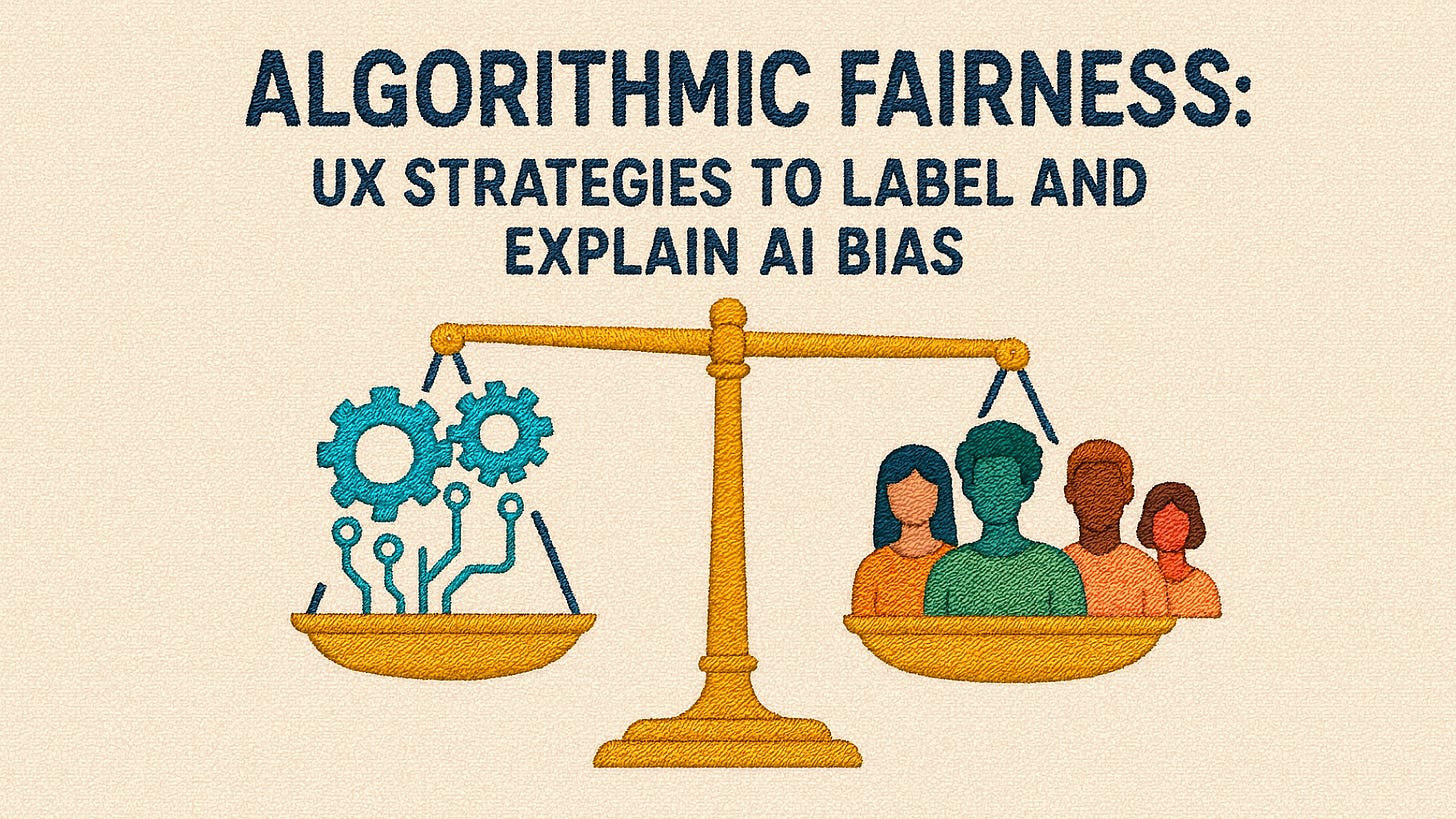Algorithmic Fairness: UX Strategies to Label and Explain AI Bias
I still recall a write-up story of a lady who applied for a credit card online, filled in all the required information, and within seconds, the system rejected her application. No explanation, no guidance. Just a cold “not eligible.”
She later found out that the AI system used for risk assessment was quietly downgrading applicants from her postal code, an area with more immigrants and lower-income households. It wasn’t about her creditworthiness. It was about the algorithm’s bias.
Moments like these remind us that technology isn’t neutral. And if UX designers don’t step in, the harm is silent, invisible, and deeply personal.
So how can we, as designers, make algorithmic decisions transparent, fair, and explainable? Let’s dive in.
What is Algorithmic Fairness?
At its core, algorithmic fairness means designing AI systems that avoid systematically disadvantaging specific groups, whether by race, gender, age, disability, or socio-economic background.
Bias creeps in through:
Historical data (e.g., past hiring trends favoring men).
Feature selection (e.g., zip codes correlating with ethnicity).
Opaque systems where users can’t see or challenge decisions.
UX plays a crucial role because it’s often the only bridge between complex AI models and real human beings.
Case Study 1: COMPAS Recidivism Tool (Criminal Justice)
One of the most infamous cases of algorithmic bias came from the COMPAS tool, used in U.S. courts to predict the likelihood of reoffending.
ProPublica’s 2016 investigation found the system was twice as likely to falsely flag Black defendants as higher risk compared to white defendants.
The problem wasn’t only the flawed algorithm, it was also the UX. Defendants had no way to see how their score was calculated or challenge the reasoning. It was a black box with life-changing consequences.
This case shows why fairness can’t be left to data scientists alone; it’s a UX issue, too.
Case Study 2: Apple Card Gender Bias Allegations
In 2019, the Apple Card, issued by Goldman Sachs, faced public backlash after users noticed women were often granted significantly lower credit limits than men, even when sharing accounts.
Tech entrepreneur David Heinemeier Hansson tweeted that his wife received a limit 20 times lower despite better credit. His complaint went viral, and the New York Department of Financial Services launched an investigation.
The issue wasn’t just algorithmic, it was also lack of explainability. Users couldn’t understand why the system made its decision. This opacity eroded trust and reputation.
UX Strategies to Label and Explain Bias
So, how do we design AI systems that are not only technically fair but also perceived as fair by users?
1. Disclosure Is Key
Don’t let users guess. When an AI system is making a decision, for example, approving a loan, ranking candidates, or curating content, explicitly disclose:
“This decision was supported by AI.”
“Key factors considered: income stability, repayment history.”
Clarity creates accountability.
2. Label Confidence & Uncertainty
AI is probabilistic, not absolute. Interfaces should show confidence ranges (“We’re 75% confident in this recommendation”) to avoid over-inflating trust.
Example: Google Translate now shows alternative translations with context, acknowledging uncertainty instead of pretending to be perfect.
3. Give Users Options
Always provide a path for review, appeal, or human intervention.
“Not satisfied with this result? Request a manual review.”
“Here’s how you can update or correct your data.”
This small design choice can drastically improve trust.
4. Guardrails for Vulnerable Users
Some decisions impact healthcare, finance, and justice, and these are areas where mistakes are costly. Here, designers must:
Use plain language explanations.
Avoid technical jargon.
Provide empathetic error messaging (not cold rejections).
5. Build for Trust with Transparency Layers
Not every user wants deep technical details. Create progressive disclosure:
Quick summary: “We considered X, Y, Z.”
Expandable detail: “Here’s how the algorithm weighs each factor.”
This layered design respects different user needs.
Case Study 3: LinkedIn’s Bias Correction in AI Recruiting
LinkedIn faced challenges with bias in its job-matching algorithms. Women were being underrepresented in certain search results.
In response, LinkedIn developed a fairness system that balances results without lowering quality. The company also built UX signals into recruiter tools, ensuring they understood how results were generated.
This shows how UX and not just backend data tweaks can actively mitigate bias and restore fairness in high-stakes domains.
The Human Layer
At the heart of algorithmic fairness is this simple truth that people deserve to know why a system treats them a certain way.
When the credit application was rejected, the absence of explanation made her feel powerless. But imagine if the interface had said: “Your application was declined because income verification was incomplete. You may reapply with additional documents.”
That small UX choice transforms an opaque rejection into an understandable, fixable pathway.
Closing Remarks
Bias in AI isn’t just a math problem, it’s a human experience problem.
UX designers hold a unique power as we can label, explain, and humanize AI decisions. By doing so, we move closer to a world where technology not only works but works fairly.
Because at the end of the day, people don’t just want fast results, they want fair results they can trust.
How do you think UX designers should approach fairness in AI systems? Should we push for more labeling, more explainability, or even user-led audits?
References
Predicting risk in criminal justice in the United States: The ProPublica-COMPAS case
Apple Card issuer investigated after claims of sexist credit checks
Apple Card Investigated After Gender Discrimination Complaints
Optimizing People You May Know (PYMK) for equity in network creation
Using the LinkedIn Fairness Toolkit in large-scale AI systems
#BlessingNuggets #UXDesign #AIUX #AlgorithmicFairness #ResponsibleAI #TransparencyByDesign


